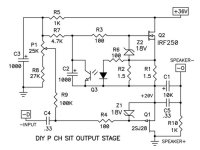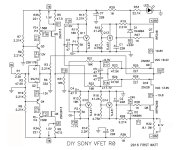Does anyone have information on the Pass Labs SIT/VFETS? Schematics of Pass Labs amplifiers that use the SIT/VFET?
His SIT amplifiers are the first of a new generation of audio amplifiers using Static Induction Transistors in a single-stage, single-ended, Class A circuit without feedback or degeneration.[13] The SIT chip combines a square-law input character with a low impedance output to form the only solid-state gain device, which Pass claims, "behaves like a triode tube." There is no output transformer on the SIT amps. The point of the SIT is that it behaves like a triode but at lower voltages and higher currents, so it doesn't need a matching transformer to deliver power to 8 Ohms. Like tubes, SITs have soft overload clipping. When brief bursts of musical energy occur, SITs react with rounded waveform tops instead of sharp and hard clipping of solid-state. SITs have a curve which looks a lot like a triode vacuum tube; low at first and climbs steadily. The distortion curve is similar, a steady rise instead of a valley with high distortion at both ends.
Is it possible Mr. Pass has invested $60m to create his SIT's?
His SIT amplifiers are the first of a new generation of audio amplifiers using Static Induction Transistors in a single-stage, single-ended, Class A circuit without feedback or degeneration.[13] The SIT chip combines a square-law input character with a low impedance output to form the only solid-state gain device, which Pass claims, "behaves like a triode tube." There is no output transformer on the SIT amps. The point of the SIT is that it behaves like a triode but at lower voltages and higher currents, so it doesn't need a matching transformer to deliver power to 8 Ohms. Like tubes, SITs have soft overload clipping. When brief bursts of musical energy occur, SITs react with rounded waveform tops instead of sharp and hard clipping of solid-state. SITs have a curve which looks a lot like a triode vacuum tube; low at first and climbs steadily. The distortion curve is similar, a steady rise instead of a valley with high distortion at both ends.
Is it possible Mr. Pass has invested $60m to create his SIT's?
Last edited:
Please provide a more detailed explanationYou seem to have summarized well but unfortunately you seems late to the party.
This is a Pass design? The VFETS shown are current day available?Something like this perhaps?
SITs are solid state! Surely the lack of hard clipping is more about the lack of global feedback, which alas brings distortion well before the onset of clipping. More linearization (via feedback) produces harder clipping, and only way to have both low distortion with soft clipping is with a special circuit (which could be done in DSP even). Then you can delay the onset of distortion to above a threshold.SITs react with rounded waveform tops instead of sharp and hard clipping of solid-state
I am not so good at reading between the lines
Apparently you are also not so good at searching, googling or making any effort to access information. It boggles the mind you even found this place 🙂
@Want to be
There are no (zero, nada, zip) SIT/VFET devices in production today. The Pass SIT was a production run of one batch, and sadly the fab that made them went out of business a year or so later for completely unrelated reasons. The Pass SIT has never been available in any product other than the various Firstwatt SIT amplifiers. (SIT-1, -2, -3. The new SIT-4 uses a NOS Tokin device)
The other SIT that people build amplifiers around are 40+yr old, and extremely rare. So you’ll need to source some yourself, then build a suitable amp for the devices you can find.
Tokin THF-51S, Tokin 2SK182ES, Tokin 2SK180
Yamaha 2SK77
Sony 2SK82, 2SJ28, 2SK60, 2SJ18
These can be made into amplifiers. That‘s the easy part. Finding them is the challenge.
And yes, they absolutely, unquestionably sound as good as you think they do. 😎
There are no (zero, nada, zip) SIT/VFET devices in production today. The Pass SIT was a production run of one batch, and sadly the fab that made them went out of business a year or so later for completely unrelated reasons. The Pass SIT has never been available in any product other than the various Firstwatt SIT amplifiers. (SIT-1, -2, -3. The new SIT-4 uses a NOS Tokin device)
The other SIT that people build amplifiers around are 40+yr old, and extremely rare. So you’ll need to source some yourself, then build a suitable amp for the devices you can find.
Tokin THF-51S, Tokin 2SK182ES, Tokin 2SK180
Yamaha 2SK77
Sony 2SK82, 2SJ28, 2SK60, 2SJ18
These can be made into amplifiers. That‘s the easy part. Finding them is the challenge.
And yes, they absolutely, unquestionably sound as good as you think they do. 😎
Better to work with little power jfet lu1014, which is available, plenty of classA amp schematics around.
Thank you for the info. That is exactly the answers I was looking for.@Want to be
There are no (zero, nada, zip) SIT/VFET devices in production today. The Pass SIT was a production run of one batch, and sadly the fab that made them went out of business a year or so later for completely unrelated reasons. The Pass SIT has never been available in any product other than the various Firstwatt SIT amplifiers. (SIT-1, -2, -3. The new SIT-4 uses a NOS Tokin device)
The other SIT that people build amplifiers around are 40+yr old, and extremely rare. So you’ll need to source some yourself, then build a suitable amp for the devices you can find.
Tokin THF-51S, Tokin 2SK182ES, Tokin 2SK180
Yamaha 2SK77
Sony 2SK82, 2SJ28, 2SK60, 2SJ18
These can be made into amplifiers. That‘s the easy part. Finding them is the challenge.
And yes, they absolutely, unquestionably sound as good as you think they do. 😎
I began this search by wondering if something was available to replace the Yamaha VFETS in the B-1 and/or B-2 Amps
2SK76 and 2SJ26
I knew that a plug and play was going to be a long shot, but maybe with some minor circuit tweaks may work.
The same issue exist with the Sony VFET Amps.
2SK76 and 2SJ26
I knew that a plug and play was going to be a long shot, but maybe with some minor circuit tweaks may work.
The same issue exist with the Sony VFET Amps.
Last edited:
Oh sure, they are being sold on eBay for $2,000.00 or moreBuy another one and hope the output devices are good.
Yes. That part of it is somewhat a bummer.
Think about it… this is dead technology, where it never really caught on for any other application aside audio, with the bulk of the production done in the 70s, and are now becoming found (again) to have some special characteristics that are beneficial for our application… it’s going to be expensive.
Think about it… this is dead technology, where it never really caught on for any other application aside audio, with the bulk of the production done in the 70s, and are now becoming found (again) to have some special characteristics that are beneficial for our application… it’s going to be expensive.
The audio market is small at only a few Billion Dollars per year and these Yamaha and Sony VFET Amps have been prized for 50 years. The demand for this Class A technology is very strong as Nelson Pass has shown.where it never really caught on for any other application aside audio
Plus not everyone can afford the $14,000.00 price tag of the Pass Labs units.
That may very well be better than buying Thousands of Dollars of Power Ball Lottery Tickets.Buy another one and hope the output devices are good.
Finding them is the challenge.
Perhaps several thousand SITs are currently in the hands of diyers. Hundreds of amps already made. The rest are just SIT hodlers 🙂
It's amusing how the buying frenzy avalanched. Just a few years ago people could not be bothered to take SITs for next to free. The Vfets otoh have always been rare and expensive.
- Home
- Source & Line
- Analog Line Level
- Schematic of Pass Labs amplifier SIT/VFET

